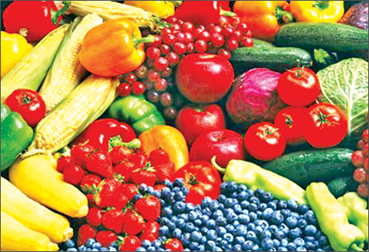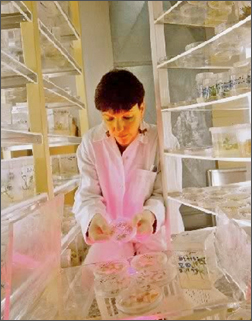The truth about GM foods
by Amal Hewavissenti

GM fruit and vegetables retain their freshness for longer |
Genetically modified food (GM food) is generally food made from
animal and vegetable varieties and produced by a process called genetic
engineering. In the market place, we are most often attracted to
brightly coloured, fresh looking jumbo sized fruit or lush green 'farm
fresh' vegetables on display. In fact, people buy these 'beautiful'
products and become physically dependent on them only to introduce their
bodies to an array of disorders.
But the reality may be quite unpalatable. Why? The irresistably
appealing taste, appearance and shape of those foods are enough to
attract anyone. However, research and experiments carried out to test
the quality and value of these foods have been compelled to give out
negative conclusions. Researchers have come to conclusions that these
foods might pose a considerable health risk in the long run. Genetically
modified fruits and vegetables strangely maintain an unnaturally fresh
colour, tone, size and pleasing taste. The regular intake of food of
this type may indeed be unhealthy.
Why genetic engineering
With the population increasing, the extent of land suitable for
cultivation is being narrowed down at a speedy pace. Under such
difficult circumstances, what really has to be done or can be done is
not merely increasing the amount of crops, but boosting the level of
productivity within the limited space. So genetic engineering has come
into operation as a means of increasing productivity because limited
land and crops are inadequate to provide food for the soaring
population. Here, genetic engineering is applied not to increase the
stocks of crops, but to produce the maximum to cater to the food needs,
which is becoming a drastically challenging task. This process involves
increasing the bulk of production rather than increasing the amount of
crops or turning barren land in to arable land which is an increasingly
difficult task.

Genetic treatment of tomatoes |
Even in food production from animal sources, the same principles are
observed. Experts on genetic engineering have focused on increasing the
bulk of a chicken, for example, to produce more meat and eggs, rather
than increasing the population of chicken. Artificially promoted and
deformed genes were thus infused into the animal to upgrade and enhance
the bulk and taste of the particular animal product. These artificially
treated, genetically deformed animals grow up in complete contrast to
their natural brothers and sisters who may not be so productive or
sizeable in appearance.

Genetic engineering |
We see that fruits and vegetables that are results of genetic
engineering develop a baffling resistance to extreme weather conditions
such as strong sunlight. These fruit and vegetables never seem to
wither, lose colour or rot, even though they are stored or kept in
market places for a long time. This definitely sounds unusual and
unnatural.
At the same time, genetically produced foods have a noticeable
tolerance to pest attacks and damage caused by fungi. Though consumers
may have their doubts about the quality and nutritional value of GM
foods their appealing appearance blind them to any adverse effects these
foods may pose. However, sellers and importers of GM foods prefer them
over others considering the huge profits they could make from these
attractive fruits and vegetables. They are less concerned about the
nutritional needs of people or the qualitative value of the imported
foods. It becomes merely a matter of competition among commercially
rival parties to grab the highest profit and market share. Thus it is
clearly noticeable that the (seeming) 'freshness' and colour of
vegetables or fruits from genetically treated crops are not a convincing
criterion for nutrition as expected by us, the consumers. This
'freshness' does not at all guarantee the high level of nutritive value
assumed to be latent in GM foods. Instead of nutrition, the dangerously
attractive foods might undermine one's health or even life in the long
run.
The effect of these foods has not yet been identified as totally
harmless or totally harmful. Yet, certain tests and experiments carried
out on them have revealed the presence of chemicals which cause serious
illnesses in the human body.
Genetically modified crops are pesticide-tolerant and
herbicide-tolerant. For example, a special variety of tomatoes was
introduced by the USA where the plant had the capacity to delay the
ripening of its fruit. This is the nature of genetically treated crops.
A solution for global hunger?
According to the World Health Organisation more than 172 million
children under ten years of age throughout the world are not taking even
the minimum level of calories needed per day. No less than 840 million
people, mostly in developing countries, are fighting a losing battle
against malnutrition. They are unable to fulfil their food needs because
of economic barriers against a background of malnutrition and hunger.
Based on economic theories and development strategies, developed
countries ruthlessly destroy their excess food stocks or use them as
animal food without giving anything to the people dying daily through
lack of food.
This trend is increasing day by day. But developed countries
tactfully cover up their actions and project the idea that a severe food
shortage is just round the corner and that GM foods are the best
solution to this predicament.
The main GM crops cultivated throughout the world are maize, soya,
cotton and canola. However, any possibility of GM foods and animals
having a catastrophic effect on people must be closely studied.
Textured vegetable protein, soy bean, soya flour, soya milk, soya
sauce, defatted soya flour, corn, maize, corn flour, maize flour, fresh
tomatoes, tomato paste, cheese, potatoes, potato products, beet sugar
and yeast are some of the main GM foods available in the market today.
How far these foods affect our health is also a major issue. These foods
are high in taste, but poor in nutritional value.
An intensive research conducted by a medical expert (Samuel Epittsson)
proved that soya milk, which contains the IGF-I hormone, increases the
risk of breast cancer by five hundred percent. The risk is proved to be
high if the particular hormone (IGF-I) is consumed repeatedly in large
quantities.
It is generally accepted that genetically produced crops are a major
threat to health and to the ecological balance. In 2005, Irina Ermakova,
a Russian doctor made a spectacular revelation. She conducted an
experiment in which 45 mice were given genetically modified soya. Twenty
five of the mice died after eating soya food.
World health experts warn that a person who consumes GM foods over a
long period is certain to develop allergenic tendencies and toxicity.
While negative reports have come from all over the world, developed
countries such as America, Japan, Canada and the European Union have
taken precautionary measures to safeguard their people from the harmful
effects of GM foods.
Mice on test?
The world's superpowers are still holding the monopoly of genetic
engineering technology and seeds and a possible solution to global
hunger falls beyond the boundaries of reality. People buy GM products
because of their wide availability.
The masterminds behind these GM foods are at work, spreading their
products throughout the world and at the same time conducting
experiments as to the possible health risks they may pose on the people
of Third World countries to whom they sell the food. They employ people
from Third World countries to gauge the risks or any potential danger of
their products, just as scientists use mice to test harmful substances.
Recently, British authorities took measures to remove GM foods from
the mid day meal of pre-school children. How about us? Should we be the
mice in a laboratory who have to die at the hand of scientists so that
they can prove their theory? We should never allow them to experiment
with our stomaches in their move to obtain a feedback on their products.
The decision lies with us! |

